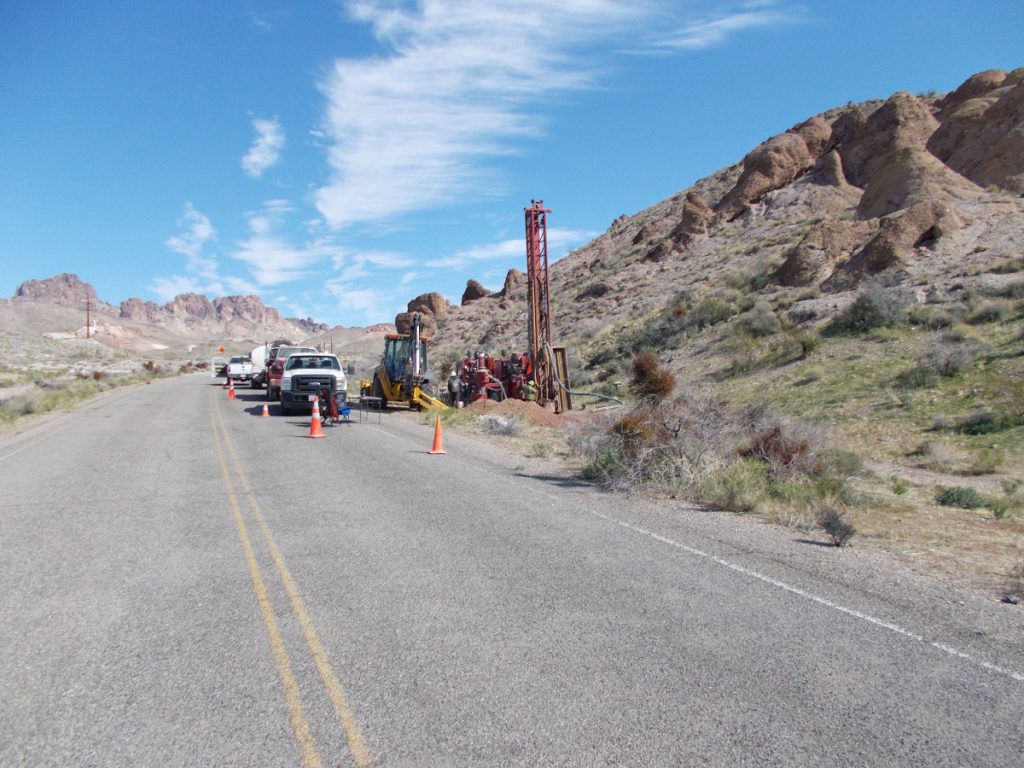Arizona Silver drills 11.81 g/t gold, 39.31 g/t silver over 2.26 metres at Philadelphia, extends high-grade zone

Drilling at Arizona Silver Exploration Inc.‘s [AZS-TSXV; AZASF-OTCQB] has extended the strike of high-grade gold-silver mineralization at the 100%-optioned Philadelphia project, Mohave County, Arizona. Assays have been returned for two holes with two further holes in the assay laboratory. Drilling is continuing.
Holes PC22-89 and PC22-90 (beneath the “shark fin”) extend the recently drilled high-grade mineralization to the north under the “shark fin”, a weakly mineralized breccia. The two holes intersected the target as predicted, confirming the “boiling zone” model that guides our exploration. A high-grade vein was intersected 45 metres down-dip from the outcrop, with the deeper of the two drill holes yielding the best thickness and grade as anticipated.
The deeper hole PC22-90 high-grade (hanging wall) vein returned 93.84 to 96.10 metres downhole depth (2.26m) at 11.81 g/t gold and 39.31 g/t silver within a high-grade-vein interval of 91.68 to 99.70 metres (8.02m) at 7.50 g/t gold and 29.07 g/t silver within the Total Mineralized Zone that returned 82.41 to 113.41 metres (31.01m) at 2.38 g/t gold and 10.58 g/t silver
PC22-89, a shallower hole, intersected the High-Grade HW Vein that returned 72.59 to 73.54 metres (0.95m) at 11.20 g/t gold and 27.88 g/t silver within the Total Mineralized Zone that returned 60.67 to 81.71 metres (21.04m) at 0.97 g/t gold and 1.33 g/t silver.
Greg Hahn, Vice President, Exploration, commented, “All of the assayed holes in this program have intersected potentially economic grade mineralization. The two new holes demonstrate how quickly the epithermal vein system changes with depth from no vein at the “shark fin”, to a narrow vein 45 metres below the outcrop (PC22-89), to a thick vein interval 35 metres deeper (PC22-90). The vein continues to depth, with intercepts in holes PC22-88 and PC22-91 (with assays outstanding).
“We followed these holes with PC22-91, a deep test below this mineralization. The rig then moved 300 metres to the south to drill PC22-92, a core drill twin of a previous reverse circulation drill hole. That hole has been completed with the drill rig now sited on PC22-93, 350 metres north of the “shark fin.” Assays are awaited,” continued Hahn.
Geologically, holes PC22-89 and PC22-90 tested the “shark fin,” a calcite cemented breccia that contains clasts of quartz vein material and altered Tr2 rhyolite. They were drilled from the same drill pad as the previous core holes but on a new azimuth of 325Ëš instead of 270Ëš.
Hole PC-91 tested down-dip of the holes reported here but was lost at 266 metres in mineralization. The zone started at 173 metres with abundant stockwork quartz in Tr2 breccia and quartz vein clasts, followed by the lower vein breccia. The drill rods became interminably stuck at 266 metres in the lower vein breccia resulting in the hole being abandoned. We plan to re-drill the hole at a later date from a different pad to complete the intercept in the footwall vein and to intersect the Arabian Fault.
The drill rig was moved to the southern access area located 300 metres south of the Section 1 holes reported above. The intervening 300 metre strike is undrilled to date pending road construction. A core hole, PC22-92 was drilled parallel to RC hole PRC21-85, which intersected 115.9 metres of 1.34 g/t gold and 5.78 g/t silver, our thickest drill intercept to date. The core twin is intended to provide a comparison of RC drilling results to core results where groundwater flow is present.
Earlier, drill hole PC22-86 at the High grade HW vein returned 32.90 g/t gold and 97 g/t silver from 85.73-86.71 metres (0.98m).
Lithologies compared quite favourably between the two drill holes. The presence of quartz in the footwall granite is readily explainable by a unique bi-lithic breccia consisting of quartz vein clasts and granite clasts below the stockwork quartz in Tr2 rhyolite, and by the continuation of stockwork quartz in the granite below the bi-lithic breccia. Both holes PC22-91 and PC22-92 are in the laboratory.
The drill is currently on hole PC22-93, located 350 metres north of the holes reported in this press release, drilling beneath a prominent hill of stockwork quartz in granite. The hole is currently down 54 metres, having intersected brecciated stockwork quartz in the Arabian Fault and in the footwall granite beginning at 27 metres depth. The hole is targeted for 180 metres, to test the full extent of the stockwork quartz system exposed on the hill.
There are no drill holes testing the 350 metre-strike length between this hole and the two holes reported in this release. Meridian Gold drilled the upper 30 metres of the hill in the early 1980s with good results, but they failed to test the down-dip potential due to right-of-way limitations at the time. Those issues were eliminated in the late 1990’s when the highway was relocated.
Arizona Silver is focused on exploring gold-silver properties in western Arizona and Nevada. The flagship asset is the Philadelphia property. The company has recently received a positive Record of Decision to drill an initial 12 exploration holes on its recently acquired Silverton gold-silver property about 100 km northeast of Tonopah, Nevada, that hosts Carlin-type targets. Drilling there will be scheduled as time and equipment allow.
Arizona Silver also has varied interests in the Ramsay silver-lead-zinc project two hours west of Phoenix, La Paz County, Arizona and the Sycamore Canyon gold-silver property in Graham County, Arizona, where drilling has been approved. The company is headed by Mile Stark, President and CEO. Arizona Silver has 64,463,225 shares outstanding with 9% held by institutions, 22% retail, 28% insiders and family and friends with 41%..
